Owls are fascinating animals. There are over 200 species of owls, and it is no secret that they are all one hundred percent cute. Owls are solitary creatures, and most are nocturnal, so they don’t get as much attention as some diurnal birds. But we are here to say that owls deserve some limelight!
Owls have feathers that are adapted for completely silent flight. They have cute round eyes with excellent eyesight, especially at night. Owls have asymmetrical ears designed to hear even the tiniest noises, necessary to locate prey. Because they are birds of prey, they have long, sharp talons to hold their catch and curved beaks to help them eat it. Owls have beautiful plumage of various patterns helping them blend in with their surroundings. Multi-colored, they and nearly impossible to see against the trunk of a tree.
Owls are extremely adorable but not often seen because their hunting strategy relies on being stealthy and surprising their prey. We aim to shine a light on some of the world’s cutest owls. Let’s get started!
Barn Owl
Barn owls (Tyto alba) are undoubtedly some of the cutest birds around. They have pale-colored feathers, long wings, and a square-shaped tail. They have cute feathered legs, a heart-shaped face, and dark, black eyes. Many barn owls have speckled patterns in various colors. Barn owls are covered in pure white down when they are newly born.
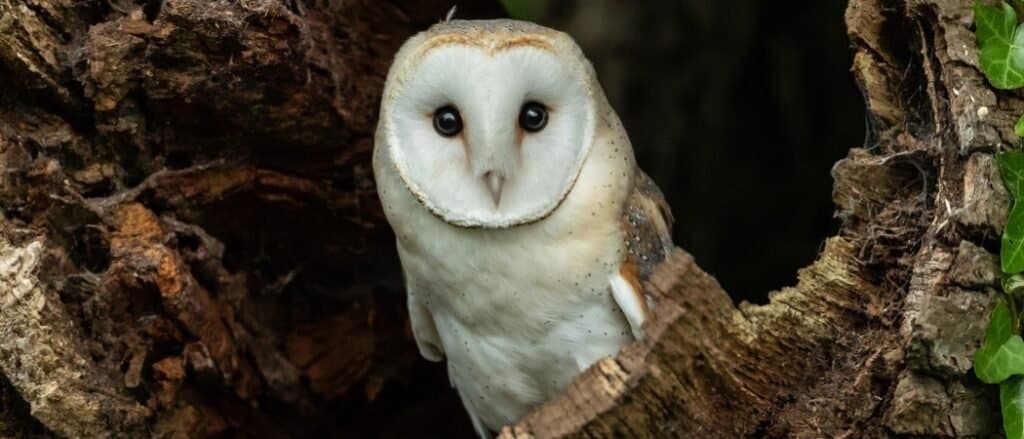
Barn owls don’t make a typical hoot-hoot owl sound.
©iStock.com/Alan Walker
These birds don’t make a typical hoot-hoot owl sound. Instead, they make a shrill shrieking sound that sounds much like a scream. They also give short twitters, hisses, chirps, and purrs to communicate. Barn owls live on every continent except Antarctica.
Snowy Owl
The snowy owl (Bubo scandiacus) has a few different names, including polar owl, white owl, and Arctic owl. These names are all an attempt to describe the owls’ beautiful white feathers and their habitat in Arctic regions. Their plumage is mostly white with dark flecks. Their feet feature long toe feathers to protect them from the cold.
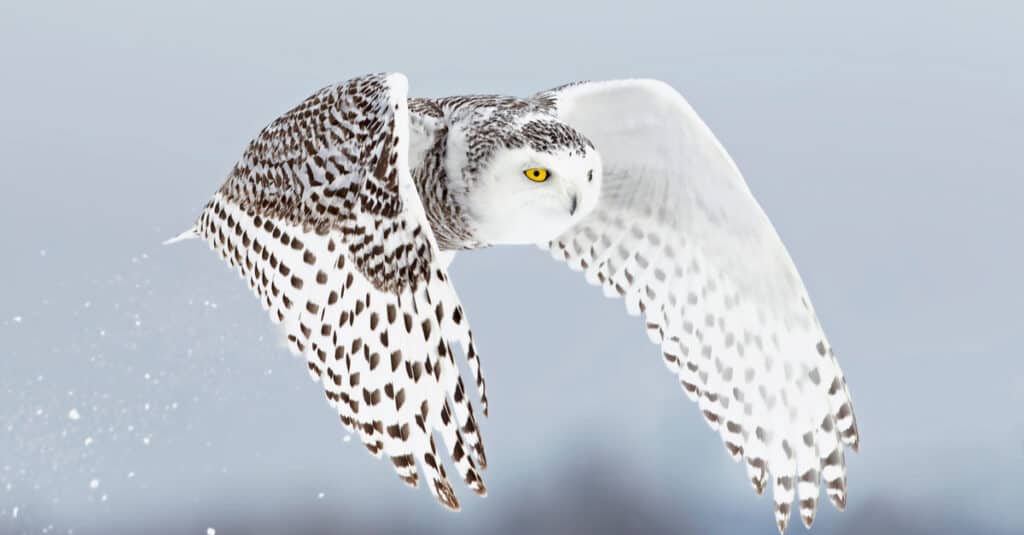
These cute owls are quite large birds, ranging in size from 20 to 25 inches in length, with wingspans of up to five and a half feet!
©Jim Cumming/Shutterstock.com
Because of their location, snowy owls eat lemmings generally, but are highly adaptable hunters and will eat whatever mammal, bird, or fish available. They are also nomadic, covering large ranges while attempting to find food. These cute owls are quite large birds, ranging in size from 20 to 25 inches in length, with wingspans of up to five and a half feet!
Great Horned Owl
Great horned owls (Bubo virginianus) are also called tiger owls and hoot owls. They are large owls with many adorable characteristics. Their coats act as camouflage with mottled brown plumage of complex shades. Undoubtedly their most winsome feature is their horns. These tufted feathers stick up and look very much like ears.
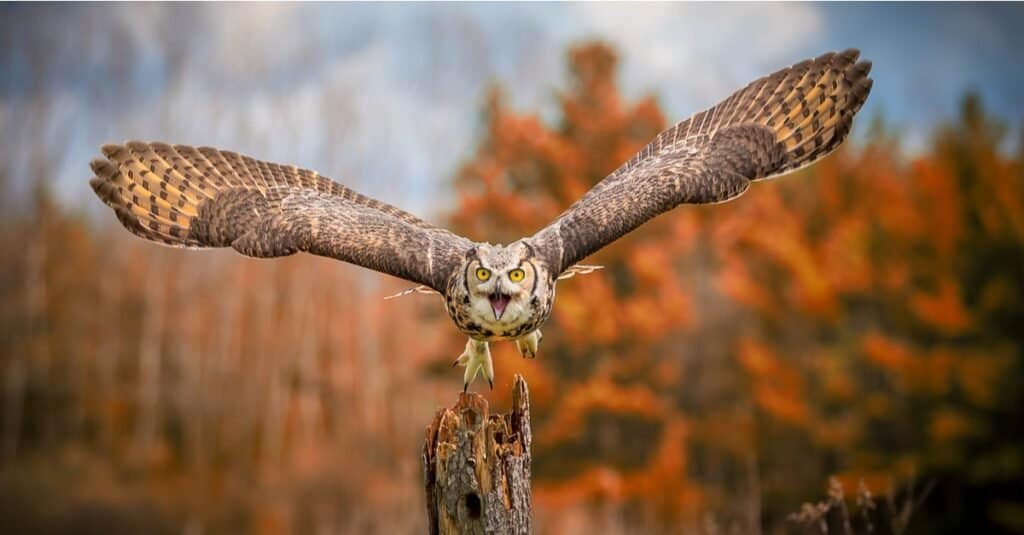
Great horned owls are exclusively nocturnal.
©Imran Ashraf/Shutterstock.com
Great horned owls are exclusively nocturnal, well-adapted to see, hear, and hunt at night. They make the characteristic hoo hoo owl sounds. Great horned owls also growl, laugh, meow, hiss, and screech to communicate. Great horned owls are considered a threatened species.
Tawny Owl
Tawny owls (Strix aluco) are also called brown owls. They are medium-sized and enchanting. Tawny owls have attractive brownish-grey feathers and a flecked, streaked, and striped pattern for excellent camouflage in the forest. These birds have round heads and brown eyes with binocular vision, making them superb hunters.

Tawny owls have round heads and brown eyes with binocular vision.
©Ramon Carretero/Shutterstock.com
Tawny owls make a lot of charming noises, like hoo hoo and kew-wick. They are also monogamous, having one life partner. The couple will defend its home territory and stay in the same area for life. They make their homes in trees or buildings, and will happily move into a man-made nesting box.
Burrowing Owl
The adorable burrowing owl (Athene cunicularia) is sometimes called the shoco. It is a small bird that makes its home in dry areas with sparse vegetation. Burrowing owls have many unique features. They nest in burrows underground rather than up in trees like other owls. They are crepuscular birds, more active at dawn and dusk. Burrowing owls have also developed longer legs and will sprint along the ground when hunting prey, though they also fly after prey, too.
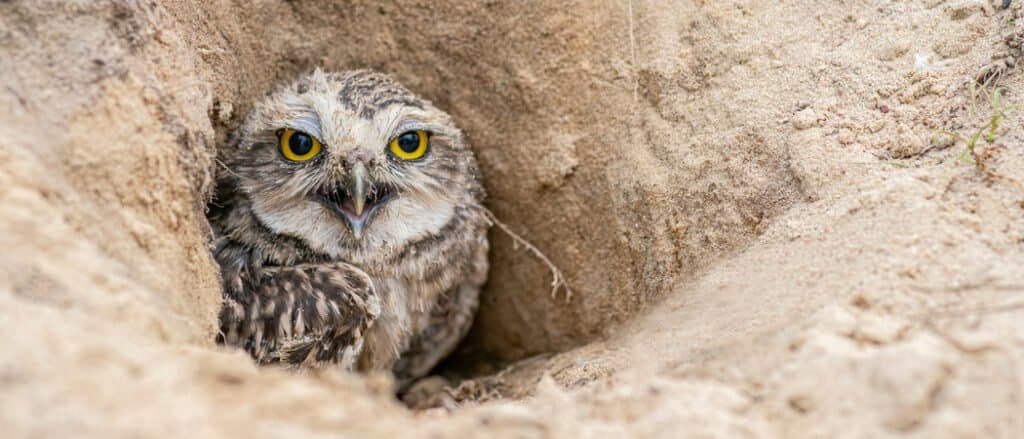
Burrowing owls nest underground rather than up in trees like other owls.
©Albert Beukhof/Shutterstock.com
These tiny birds have big round eyes and beaks that are brown or yellow. They have bewitching white eyebrows and a splash of white around their chin. Burrowing owls are threatened or endangered in due to habitat loss, as well as programs designed to control prairie dog populations.
Little Owl
The little owl (Athene noctua) is also called the owl of Athena and the owl of Minerva. These birds definitely deserve a spot on the world’s cutest owl list. They have flat-topped heads and rounded bodies with short tails. They have greyish-brown feathers with darker spots and lighter stripes.

The little owl is also called the owl of Athena and the owl of Minerva.
©WildlifeWorld/Shutterstock.com
Little owls are very hard to spot, which they use this to their advantage in hunting by perching on a branch and surprising small creatures that happen by. They also eat insects and worms. They are not nomadic, living in one territory for a lifetime.
Little owls make various sounds, including whistles, trills, chatters, barks, and a kiew kiew sound.
Elf Owl
The elf owl (Micrathene whitneyi) is a little cutie about the size of a sparrow, and are known for having yellow eyes and white eyebrows. They are very light (only 1.4 ounces) and have a wingspan of ten inches.
Elf owls tend to make their homes inside woodpecker holes that they find in trees and tall cacti. Crepuscular animals, they hunt at dawn and dusk, subsisting on arthropods like moths and crickets.

Elf owls are known for having yellow eyes and white eyebrows.
©Agami Photo Agency/Shutterstock.com
Elf owls are territorial. They let other creatures know the boundaries of their territory through song and use a variety of noises to communicate. Elf owls chuckle or whinny like a horse in complex patterns. Loss of native habitat and declining water reservoirs pose a threat to these captivating birds. .
Eurasian Eagle Owl
The Eurasian eagle owl (Bubo bubo) is simply gorgeous. This large owl has a wingspan of up to six feet! They have ear tufts that make them appear to be always paying attention. They are a tawny brown with dark brown and cream spots, bright orange eyes, and fluffy feathers on their chests.
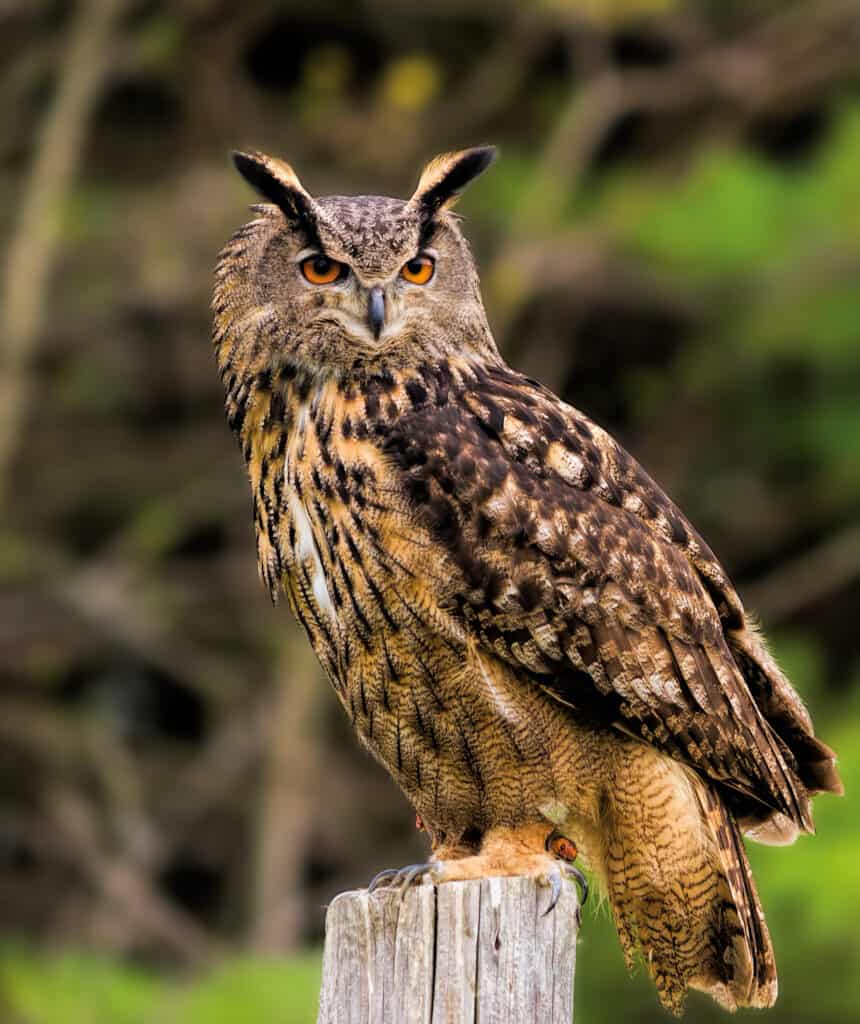
The Eurasian eagle owl has a wingspan of up to six feet!
©LesPalenik/Shutterstock.com
Eurasian eagle owls make their homes in rocky areas, favoring cliffs and ravines surrounded by trees. They are largely nocturnal and hunt small mammals, fish, and reptiles at night.
Eurasian eagle owls sing territorial songs and are most vocal and sunrise and sunset.
Crested Owl
Crested owls (Lophostrix cristata) are adorable. They have long white ear tufts set against darker plumage. These medium-sized owls also have white eyebrows that are quite fetching!
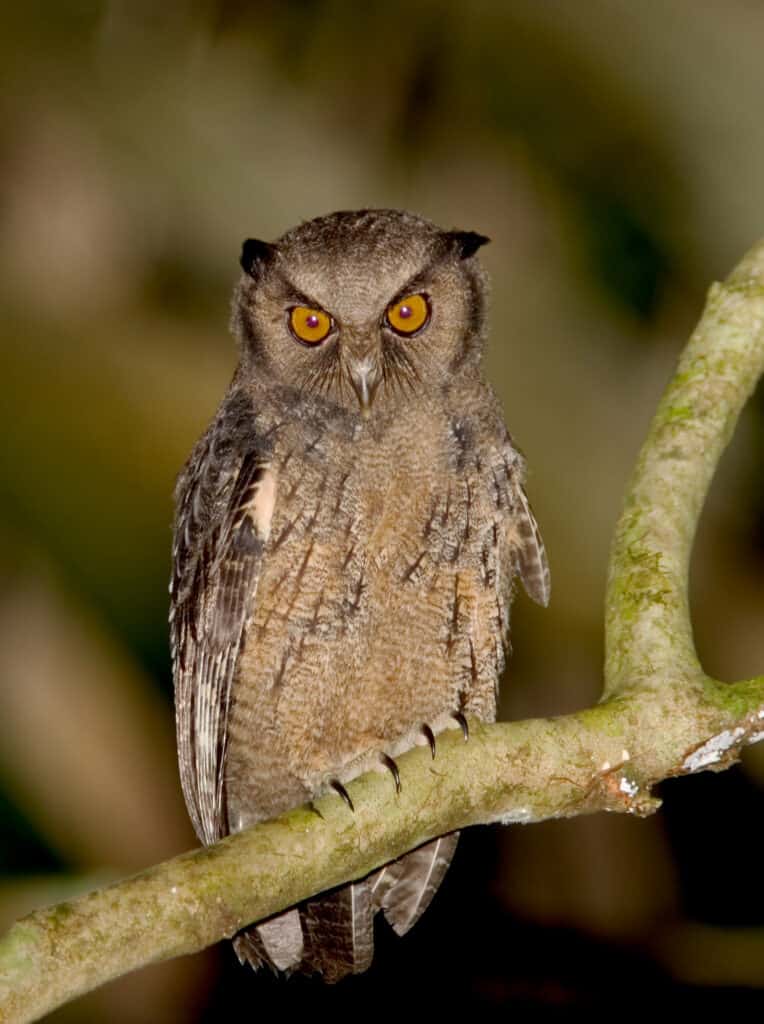
Crested owls make their home near water and prefer lowland forests that experience occasional flooding.
©Ra’id Khalil/Shutterstock.com
Crested owls make their home near water and prefer lowland forests that experience occasional flooding. They feed mainly on insects but will also eat smaller vertebrates. They are nocturnal owls that perch on high branches, waiting for prey to happen along. Crested owls make a series of songs that sound like a frog croaking.
Northern Pygmy Owl
The Northern pygmy owl (Glaucidium californicum) is last but not least of the cutest owls in the world. These small owls are only between six and seven inches long. They have a round head covered in white spots and a beautiful long tail. Two two black spots ringed in white look like eyes on the back of their head! Their feathers are multiple shades of white, brown, black, with cream stripes. They are incredibly hard to see in the forest due to their excellent camouflage.

Northern pygmy owls live in forests and wetlands, often near streams.
©Jordan Feeg/Shutterstock.com
Northern pygmy owls are native to Western North America. They live in forests and wetlands, often near streams. Northern pygmy owls nest in holes in trees. They perch on top of branches when seeking prey, which consists of mammals, birds, and insects.
Incredible Owl Facts
- Owl feathers are not waterproof, so they cannot hunt in wet weather.
- Owls can see far away but not close up.
- Owls regurgitate the undigestible parts of their dinner, like bones, scales, and fur.
- Owls have the largest brains of any birds.
- Many owls have ears that are at different heights on their heads. This feature allows them to locate prey precisely.
- Owl eyes are tube-shaped, like a pair of binoculars.
- Owls can rotate their head 270 degrees.
- A group of owls is called a parliament.
- Some owls have eyesight so acute they can locate prey half a mile away.
- Some owls swallow their prey whole.
Up Next:
- Owl Predators: What Eats Owls?
- Are Owls Dangerous?
- 5 Extinct Owls
- Meet The 7 Cutest Axolotls In The World
The photo featured at the top of this post is © Agami Photo Agency/Shutterstock.com
Sources
- , Available here: https://authors.library.caltech.edu/62714/
- link.springer.com, Available here: https://link.springer.com/chapter/10.1007/978-3-662-05957-9_25
- sciencedirect.org, Available here: https://www.sciencedirect.com/science/article/pii/0042698973901016
- royalsocietypublishing.org/, Available here: https://royalsocietypublishing.org/doi/abs/10.1098/rspb.2005.3052
- www.jstor.org, Available here: https://www.jstor.org/stable/3808896
- link.springer.com, Available here: https://link.springer.com/article/10.1007/BF00324636
- www.jstor.org, Available here: https://www.jstor.org/stable/3783689
- journals.plos.org, Available here: https://journals.plos.org/plosone/article?id=10.1371/journal.pone.0175597
- ir.library.oregonstate.edu, Available here: https://ir.library.oregonstate.edu/concern/graduate_thesis_or_dissertations/2b88qh550
Thank you for reading! Have some feedback for us? Contact the AZ Animals editorial team.






